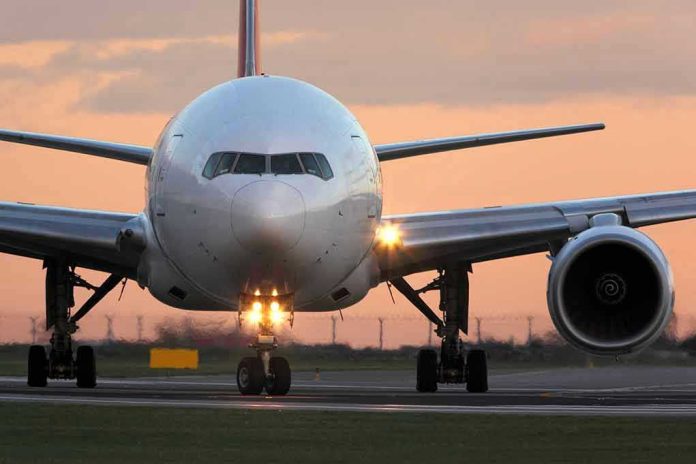
One rogue piece of hardware in a data center left tens of thousands of travelers grounded, exposing the high-wire act of modern airline technology—and how quickly it can all unravel.
Story Snapshot
- Alaska Airlines grounded all flights nationwide due to a sudden IT system failure.
- 229 flights were canceled, stranding passengers and leaving airports scrambling.
- The outage highlights the airline industry’s vulnerability to technological breakdowns.
- Even after flights resumed, disruptions and logistical headaches lingered for days.
The Day All Flights Stopped: Anatomy of a Nationwide Grounding
Alaska Airlines faced a technological reckoning Thursday morning when a catastrophic IT outage forced every one of its flights—and those of subsidiary Horizon Air—to a complete standstill across the United States. A routine morning quickly turned chaotic as digital flight boards nationwide flashed “CANCELED” next to every Alaska Air flight. The culprit: a critical hardware failure at a key data center, paralyzing the company’s digital nervous system and exposing a rarely seen level of operational vulnerability.
Passengers, expecting business as usual, instead found themselves corralled in terminals with little information and even less recourse. Alaska Airlines responded by issuing a nationwide ground stop, a dramatic move that underscored the scale of the disruption. Within hours, 229 flights were canceled, with ripple effects reaching far beyond Alaska’s Seattle headquarters. Airport staff and ground crews scrambled to manage crowds and reroute stranded travelers, all while the true extent of the outage emerged in real time.
Inside the Chaos: When Technology Fails an Industry Built on Precision
Flight operations today depend on a lattice of digital systems—from crew assignments and maintenance logs to passenger bookings and real-time weather feeds. The Alaska incident laid bare a simple truth: when this digital backbone breaks, so does the entire operation. The outage occurred at a moment of heightened complexity, as Alaska Air Group had recently expanded its portfolio by acquiring Hawaiian Airlines, increasing both its market reach and its operational complexity. Notably, Hawaiian’s flights continued unaffected, highlighting the siloed nature of airline IT systems and the challenges of integrating new acquisitions.
Veteran travelers may recall previous IT meltdowns at Southwest and Delta, but Alaska’s crisis stands out for its sheer comprehensiveness—every aircraft grounded, every schedule upended, every passenger affected. Such events have become more frequent as airlines stretch aging infrastructure and layer on new technologies. The promise of efficiency is always shadowed by the risk of a single point of failure, a risk that manifested with brutal clarity in this case.
After the Outage: Scramble, Recovery, and Industry Reckoning
By Friday, Alaska Airlines had resumed operations, but the aftershocks were far from over. The logistics of repositioning crews and aircraft proved daunting, leading to further delays and a lingering backlog of frustrated passengers. Alaska’s public statements urged travelers to check flight status before heading to the airport, tacitly acknowledging the persistent uncertainty. Behind the scenes, executive leadership and IT specialists worked overtime to restore order and assess the root causes, while customer service teams faced a tsunami of rebooking requests and compensation claims.
The wider industry took note. Airlines across the United States and beyond have invested billions in digital infrastructure, yet the Alaska Airlines event reinforced that even well-funded systems can fail spectacularly. Experts warn that as operations become more digital and interconnected, the probability and consequences of IT failures only grow. Calls for more robust backup systems, better disaster recovery protocols, and stricter regulatory oversight gained renewed urgency. The incident also reignited debate about the risks and rewards of airline consolidation, with some analysts arguing that increased complexity raises the stakes for technological resilience.
Resilience or Risk: The Future of Airline Technology Under the Microscope
Industry voices from aviation analysts to technology consultants agree: airline IT resilience is no longer a back-office concern—it is a mission-critical imperative. Alaska Airlines now faces not only the immediate costs of canceled flights and compensation, but also the potential for long-term reputational damage and loss of customer trust. Regulators and policymakers are likely to scrutinize airline risk management more closely, while passengers—now all too aware of the fragility behind their travel plans—may demand more transparency and accountability.
The Alaska Airlines outage was not an isolated blip but part of a growing pattern of high-profile airline IT failures. Each incident adds pressure for modernization, redundancy, and resilient design. For travelers, the lesson is clear: in an age where technology underpins every takeoff and landing, the question is not if, but when, the next digital domino will fall—and how well prepared the industry will be when it does.
Sources:
KSL: Alaska Airlines Resumes Operations After IT Outage
OPB: Alaska Airlines Resumes Operations After IT Outage












